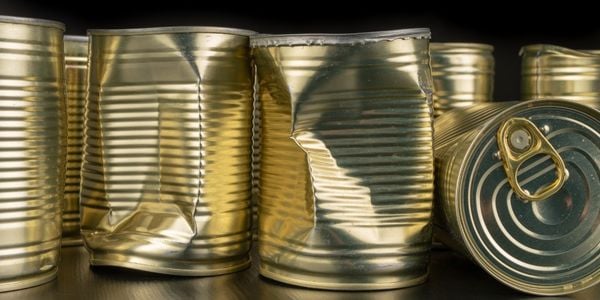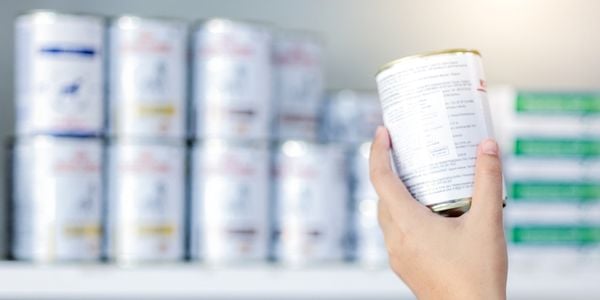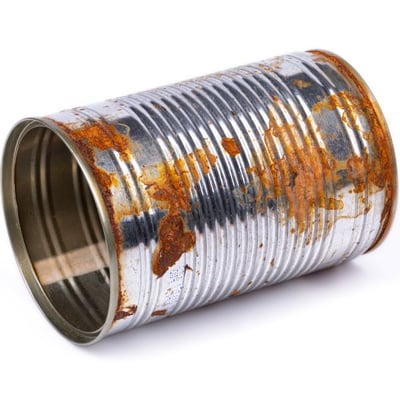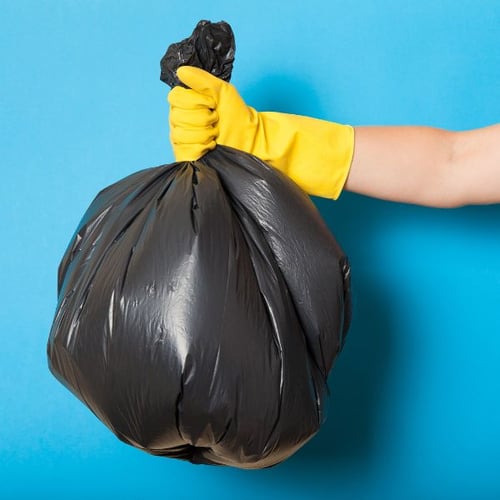
I was watching a movie once where the main character would take cans of food he wanted to buy and "drop" them so they would dent. He did this because dented cans were sold for half off. At the time, I thought they were sold at a discount because they weren’t visibly appealing with a dent.
With time comes wisdom (well, at least a little bit in my case), and now I know it wasn’t what was on the outside that mattered. It was the risk of what could be lurking on the inside – the bacteria Clostridium botulinum.
We have all grabbed a case of canned food for our pets from the pet store or the vet’s office and discovered (only after arriving home!) that some of the cans were dented. You are likely wondering if you can safely feed your pet food from a dented can.
Botulism Is a Potential Risk to Dogs and Cats
So, is it safe to feed pet food from a dented can? Well, as with many things in life, there isn’t really an easy “Yes or No” answer. It can be perfectly safe to do so in some cases while not so in others. So here’s some information and some guidelines to help you make the best decision when confronted with the scenario of a dented can.
If you have cats, you might be thinking that the best way to avoid this problem is just to feed your cats dry food. Please reconsider and make sure you are aware of the serious condition, urinary (urethral) ubstruction (ESPECIALLY if you have a male cat!).
Canned cat food has less carbs, so it's great to feed overweight cats.
And it is recommended to feed diabetic cats canned food to help not only decrease carbs but also help them lose or maintain weight.
Details About Botulism
The CDC had 242 cases of botulism in people reported to them by health departments in 2018. Of those cases, only 7% were foodborne. Though the incidences seem rare enough to take a chance, it isn’t if your pet or you are one of the unlucky ones.
- Botulism is caused by a toxin produced by certain strains of Clostridial bacteria
- Clostridium are anaerobic bacteria, meaning that they grow and thrive in an environment WITHOUT oxygen (such as a can of food)
- Botulism-causing bacterial spores CANNOT be killed by standard cooking methods where food is heated to about 212 degrees Fahrenheit. So, please don't attempt to save a dented can, thinking cooking will prevent illness.
- It takes only a very small amount of the Clostridial toxin to sicken and potentially kill an animal (or a person)
- You cannot smell, see, or taste the Botulism-causing toxin (or the Clostridial bacteria that produce it).
- The toxin can infect you by ingesting it and by absorption into open wounds or cracks in the skin. Additionally, if you touch your face after handling contaminated food, it can be absorbed through the mucus membranes in the eyes and nose. It cannot be absorbed through intact skin.
- Botulism used to occur far more often back when most canning was done in the home. It happens very infrequently now that most canning is done in factories where strict cleaning and sanitization procedures are (supposed to be) followed.
- C. botulinum, within three weeks, can produce toxins at a temperature as low as 46.4 degrees Fahrenheit. This is the temperature that cold foods are generally exposed to in stores and at home.
- Low storage temperatures for refrigerated and processed foods with extended durability must be stored at colder than 38 degrees Fahrenheit. This is needed to prevent the growth and formation of the toxin.

The Clostridial bacteria can contaminate food after it has been canned if the can becomes dented or damaged in such a way that the seal on the can is broken.
The most concerning dents in cans are:
- Those that are deep (you can lay a finger in), especially ones with sharp edges
- Those that have clearly resulted in a puncture in the surface of the can
- Those that happen near and involve the seams or rim along the top, bottom, or side of the can.
Note: Discard any can that has a dented rim, even if it is tiny.
- Heavily rusted cans can have tiny holes not visible to the eye where bacteria can enter.
Note: If you ever open a can and see rust inside, even if there is none on the outside, DO NOT eat the food and discard it immediately. Rust is unsafe to consume.
Note: If a can only has surface rust (rust that is easily removed with a paper towel or finger), the food should be safe to consume, as the rust didn't "eat" through the can.
Other types of contaminated cans
- Contaminated cans may have a bulging (bloated appearance) as a result of the gas the bacteria produces.
- Contaminated cans may be leaking as a result of freezing, overfilling during processing, denting, or spoilage bacteria (the bacteria that decompose food and C.botulinum).
- Contaminated cans may “spray” or explode their contents when opened.
- Contaminated cans may “give” or make a popping sound when you press on the top, side, or bottom of them.
- Contaminated cans may cause a color change to the food, or clear liquids may appear milky.
- Contaminated cans may cause foods to have a foul odor.
How Botulism Affects Dogs and Cats
Fortunately, cats and dogs seem to be less sensitive to the Clostridial toxins than people, though cases do occur. These cases tend to happen more from outdoor and free-roaming pets eating the carcasses of decomposing animals than they do in pets being fed commercially canned foods. Here’s one case that affected two dogs in France, and here’s a report of what is believed to be the first naturally occurring case in cats.
Signs of Botulism in Pets
The development of symptoms can take hours to days. In some cases, the onset of symptoms may take up to 6 days.
- Hind limb weakness that progresses to the front limbs and muscles of the head and face within 24 hours
- Difficulty chewing and swallowing
- Increased salivation
- Inflammation of the eyes
- Death (due to paralysis of the diaphragm, which affects the lungs and heart). This can occur rapidly once paralysis occurs without intensive and proper supportive care. The antitoxin (treatment) is not effective once signs of paralysis occur.
So, while Botulism from dented or damaged cans of cat or dog food may not be a likely occurrence, it is still a possibility. With that in mind, I would leave you with this advice when confronted with a damaged can of pet food. Inspect the can closely using the criteria listed above.
- if it’s clearly got the signs of a contaminated can, don't feed the food to your pet
- if it clears the tests above, then it’s likely to be OK
- when in doubt, or just to be as safe as possible, throw it out (or better still, return it to the place you bought it from for a replacement or refund). Why take the chance?!
How to Dispose of ‘Bad' Cans
Anything you suspect is "bad" needs to be disposed of safely. DO NOT open any suspect cans to empty the contents and recycle the can. If you do, you risk contaminating the environment or exposing yourself.
Double bag the can in a leak-proof plastic bag and close it tightly. Dispose of the bag in an outside trash container that is lockable so that there is no risk that pets, children, or anyone else will rummage through the trash.
Be sure to properly clean any surfaces that the cans came into contact with.
The best way to disinfect for botulism in your home is:
- Combine 2 cups of water with ¼ cup of bleach
- Thoroughly cover the area with the solution
- Layer with 5 to 10 paper towels (or more), and be sure to cover the entire area
- Let sit for at least 15 minutes
- While wearing rubber gloves, use liquid soap and water to remove the bleach solution
- Dispose of all paper towels, sponges, rags, and gloves used in the process in a double bag
- For at least two minutes, wash your hands with soap and running warm water
NOTE: While disinfecting the area, be sure that all pets are prevented from having access until the entire process is complete.




